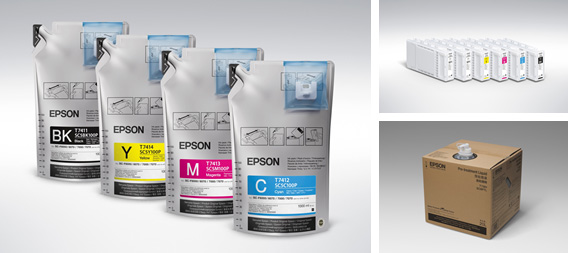汚染防止・化学物質管理
ヒトや生態系への影響を最小化するため、「製品含有化学物質管理」「生産工程での化学物質管理」「環境リスクマネジメント」に取り組んでいます。また、さまざまなステークホルダーとのコミュニケーションを大切にしています。
製品含有化学物質管理
商品を構成する一つ一つの部品・原材料において環境負荷の少ないものを優先的に調達しています。
製品含有化学物質管理の仕組み
欧州RoHS指令、REACH規則、米国TSCAなどをはじめとした国際的な化学物質規制の厳格化により、商品に使用される化学物質の管理を適切に実施することが今まで以上に重要になっています。エプソンではこのような化学物質規制を遵守すべく、購入・生産・出荷の各段階で下記のような取り組みをしています。

- サプライヤーに「エプソングループ生産材グリーン購入基準書*1」の遵守を依頼
- 法規制などで制限される化学物質の排除、部品・部材の含有物質情報の入手*2

- 部品・部材に法規制で制限される化学物質がないことを確認し、商品を生産
(部品・部材の蛍光エックス線分析装置による検査を実施)

- 商品が法規制などで制限される化学物質を使用しない部品・部材で作られたことを確認し出荷
*1 商品に使用される部品・部材を納入いただくサプライヤーに製品含有化学物質保証体制の構築・維持、法規制などで制限される化学物質の排除、部品・部材の含有物質情報の提供などの要求事項を定めた基準書
*2 業界標準調査ツールchemSHERPA(ケムシェルパ)の活用
製品含有化学物質管理の対応事例
法規制の遵守
化学物質規制は、世界各国・地域に拡大してきています。こうした法規制の情報や化学物質の有害性に関する情報を、業界標準調査ツールなどを活用していち早く入手・分析し、規制に適合する商品を提供します。
- 事例1:欧州 RoHS指令*1への対応
欧州RoHS指令に対しては、欧州向けに限らずエプソンが全世界に販売する商品について対応することを基本としています。
*1 欧州RoHS指令とは、電気・電子製品を対象に、鉛・水銀・カドミウム・六価クロム・PBB(ポリ臭化ビフェニル)・PBDE(ポリ臭化ジフェニルエーテル)・特定フタル酸エステル(DEHP、BBP、DBP、DIBP)の10物質群の使用を制限する、欧州連合が実施する有害物質規制です。
- 事例2:欧州 REACH規則への対応
欧州の化学物質規制「REACH」(Registration, Evaluation, Authorization and Restriction of Chemicals) では、化学物質を製造・輸入する際の登録、商品に有害物質(高懸念物質:SVHCなど)を含有する際の情報伝達や届け出などを義務付けています。これに対しエプソンは、2021年1月から義務化された欧州廃棄物枠組み指令に基づくSCIPデータベース(Substances of Concern In articles as such or in complex objects (Products))による情報伝達に対応しています。また、インクなどに含まれる化学物質の情報をお客様がいつでも閲覧できるよう、欧州24カ国語で作成した安全データシート(SDS)を欧州販売会社のホームページで公開するなどの必要な対応を積極的に行っています。
欧州以外の国や地域においても同様の法的要求・お客様の要求・社会的要求への確実な対応を行っています。
- 事例3:GHS*2への対応
2003年の国連勧告により、消費者・販売業者に対する化学品の危険有害性および適切な取り扱い方法に対して、世界的に統一されたルールとしてGHSへの対応が求められています。このルールは国や地域ごとに異なる時期に法規制として対応が義務化されており、エプソンは、インクカートリッジやトナーカートリッジなど対象となる化学製品に対して、表示などの対応を進めています。
*2 GHS(Globally Harmonized System of Classification and Labelling of Chemicals)とは、化学品の危険有害性(ハザード)ごとに分類基準とラベルや安全データシートの表示方法を調和させ、世界的に統一されたルールとして提供するものです。
- 事例4:IEC 62474への対応
エプソンは、IEC 62474の報告対象物質リストに基づき、サプライヤーから製品含有化学物質に関するデータの提供を受け、エプソン製品の含有化学物質の管理を行っています。
なお、IEC 62474の報告対象物質のうち、欧州RoHS指令の適用除外や欧州REACH規則のSVHCなど一部の物質を除き含有はありません。
各種印刷物に対応したインクの提供
インクジェット技術を活用して作られる商品(ラベル・ステッカー・布地など)に求められる、化学物質の安全性能を満たすインクを提供していきます。
- 事例1:テキスタイル用に安全性の高いインクを提供
エコパスポート*3認証取得
エプソンの捺染プリンター用のインク*4は、繊維製品の化学物質に対する国際的な安全規格である「エコパスポート」認証を取得しています。乳幼児が触れる繊維製品に印刷しても安全であることの証しであり、安心して使うことができます。


*3 繊維製品の生産時に使用する染料・顔料/助剤/仕上加工剤を対象とした、化学物質に対する安心・安全の認証規格です。
*4 昇華転写用プリンター向け「UltraChrome DSインク」、ガーメントプリンター向け「UltraChrome DGインク」と前処理剤、インクジェットデジタル捺染機のインクが対象です。
- 事例2:食品ラベル印刷用インクの安全性を保証
欧州食品接触材規則(欧州FCM)適合*5
エプソンのデジタルラベル印刷機「SurePressシリーズ」およびカラーラベルプリンター「ColorWorksシリーズ」のインクは、世界標準レベルの欧州食品接触材規則「Food Contact Material regulation(EC No.1935/2004)」(通称:欧州FCM)に適合しています。
*5 食材非接触面に印刷した場合のみ

より安全な材料への切り替え(有害物質の排除など)
含有禁止、あるいは含有量を管理すべき化学物質を社内基準で定め、データベース化し、設計から調達、量産に至るすべてのプロセスでこのデータベースを活用して安全性を確保しています。また、環境や人体へ影響をおよぼす可能性のある物質を商品から排除しています。
危険有害情報の提供
- 事例:プリンター用消耗品の安全データシート
プリンターに使用する消耗品(インクカートリッジ、トナーカートリッジ、リボンカートリッジなど)を、安全かつ適切に取り扱っていただくために、消耗品が含有する化学物質の内容、取り扱い方法、保管方法などを記載した、「安全データシート」の提供を行っています。
化学物質管理(パフォーマンス)
エプソンは、生産工程で取り扱う化学物質の管理として、グループ使用禁止化学物質など使用規制する化学物質を定めるとともに、各拠点において化学物質の安全審査を確実に行うことで、使用開始前の段階で化学物質を管理する仕組みを構築しています。また化学物質データ管理システム「E-Chem」を用いて、生産などに使用する化学物質情報を登録し、化学物質の使用量やPRTR(化学物質排出移動量届出制度)対象物質およびVOC(揮発性有機化合物)の排出量を管理しています。
フロン類物質に関しては、日本においては「フロン排出抑制法」に基づく関連機器の点検や、漏洩量の算定を行い、法遵守を徹底しています。エプソングループは現時点では報告要件未満の漏洩量で推移しています。
フロンは二酸化炭素の数百倍から1万倍以上の非常に大きな温室効果があります。地球温暖化防止の観点で、エプソンはフロン類冷媒の漏えいの回避に取り組むことに加え、温室効果の小さい冷媒への転換を進めていきます。
これらの化学物質に関するデータを報告・公開し、地域の皆様と意見交換会を通じてコミュニケーションを図り、信頼関係を築いています。
PRTR対象物質排出量、VOC排出量はESGデータ(化学物質)をご覧ください。
関連情報
環境リスクマネジメント
事業活動によって環境を汚染した場合、周辺住民の皆様や国・地域に多大な損失や悪影響を及ぼしかねません。エプソンは、環境汚染防止に関するグループ統一基準を定め、環境リスクマネジメントの考え方や法令遵守を徹底しています。各推進組織ではISO14001を活用し、基準値の逸脱、環境に関する苦情や事故につながるリスクを洗い出し、評価しています。その結果に基づき対策を講じ、継続的なリスク低減に努めています。
2023年度は排水に関する法基準超過が2件ありましたが、速やかな行政報告および設備改善などにより対応を完了しています。いずれも環境に重大な影響を与えるものではありませんでした。なお、苦情・事故・行政処分はなく環境関連の罰金もありませんでした。
| 種別 | 内容(件数) |
|---|---|
| 法基準値超過 | 下水道放流基準超過(2件:油分、不溶性物質) |
環境デューデリジェンス
企業や土地の新たな取得(M&A)にあたって、デューデリジェンスの一つとして環境側面を考慮した調査を行っています。生産拠点のみならず、新規取得拠点を対象とし、土壌・地下水汚染や有害廃棄物などの問題の有無を事前に把握しています。
土壌・地下水浄化活動
エプソンは、事業所などにおける土壌・地下水汚染の現状を把握し、浄化・対策に取り組んでいます。また、化学物質による汚染の未然防止とリスク低減のため、漏洩対策をはじめとする環境関連設備の安全対策も進めています。
過去の事業活動によって、2023年度現在で汚染が確認されている事業所は6事業所です。自主調査で確認された本社事業所をはじめとする地下水のトリクロロエチレン基準値超過事業所においては、敷地外への流出を防止するためのバリア対策および揚水浄化を継続的に実施しています。これらは長期にわたる対策が必要となりますが、現在は範囲および濃度ともに長期的には減少傾向にあり、敷地外へ流出していない事も定期的にモニタリングしています。
一方、土地の形質変更時など、土壌汚染対策法で定められた調査を行った際に新たな汚染が確認された場合は、行政へ報告を行い、事業所ごとの状況に応じた浄化・対策を実施するとともに行政と連携して情報を公開していきます。
今後も法令や浄化技術の発展状況をふまえた適切な方法で浄化を進めるとともに、行政や近隣の皆様とのコミュニケーションに努めていきます。
| 事業所 | 対象物質 | 対策状況 | 原因 | 汚染確認の経緯 |
|---|---|---|---|---|
| 本社 | 地下水:トリクロロエチレン | バリア対策、揚水浄化、モニタリング | 過去の事業活動による使用 | 自主調査(法規制化以前) |
| 富士見 | 地下水:トリクロロエチレン | バリア対策、揚水浄化、モニタリング | 過去の事業活動による使用 | 自主調査(法規制化以前) |
| 諏訪南 | 地下水:トリクロロエチレン | バリア対策、揚水浄化、モニタリング | 過去の事業活動による使用 | 自主調査(法規制化以前) |
| 塩尻 | 地下水:トリクロロエチレン | バリア対策、揚水浄化、モニタリング | 過去の事業活動による使用 | 自主調査(法規制化以前) |
| 土壌:フッ素、鉛 | 封じ込め(被覆)、モニタリング | 事業活動による使用履歴なし 特定できず | 土壌汚染対策法に準ずる調査(建設計画) | |
| 広丘 | 土壌:ヒ素、フッ素、鉛 地下水:ヒ素 |
封じ込め(被覆)、モニタリング | 事業活動による使用履歴なし 特定できず | 土壌汚染対策法に準ずる調査(社員寮解体) |
| 伊那 | 土壌:フッ素、鉛、トリクロロエチレン | 封じ込め(被覆)、モニタリング | 過去の事業活動による使用 | 土壌汚染対策法に準ずる調査(工場建物解体) |
排水管理
当社の千歳事業所は国指定鳥獣保護区やラムサール条約湿地などに指定・登録されている「ウトナイ湖」の上流に位置しています。
製造工程で使用した廃水は、無害化処理後に下水道へ排出しています。また薬液などの漏えいによる敷地外への流出を防ぐため、敷地内に降雨した雨水を事業所内の調整池にてpH、油分監視後、美々川を経由し千歳湖・ウトナイ湖へ流入しています。薬品保管、廃棄物置き場や廃水処理設備は全て屋内に設置し、敷地外への漏えい事故を起こさないようにしています。
廃棄物管理
エプソンの社内規程により、排出物は発生国内で処理することが定められており、現在バーゼル条約に定められている有害廃棄物および他の廃棄物を直接輸出入していません。
ただし、蛍光ランプなどの処理が困難な該当国・地域に関しては、バーゼル条約の条件を満たしている協力会社へ委託しています。
PCB廃棄物保管状況
国内エプソングループにおいて2022年度までに発見、保管していたPCB廃棄物については処理を完了しています。
なお、今後新たにPCB廃棄物が発見された場合は法に基づき適正な処理を速やかに実施します。
アスベストへの対応
国内のエプソングループが所有する全ての建物について2019年度までに調査を行いました。確認されたレベル1、レベル2については囲い込み・封じ込め工法、および必要に応じて除去工事を実施し、従業員および関係者の暴露防止に努めています。また、囲い込み・封じ込め部を含め、屋内にアスベスト含有建材が使用されているエリアについては定期的に気中測定を行い、安全を確認しています。



